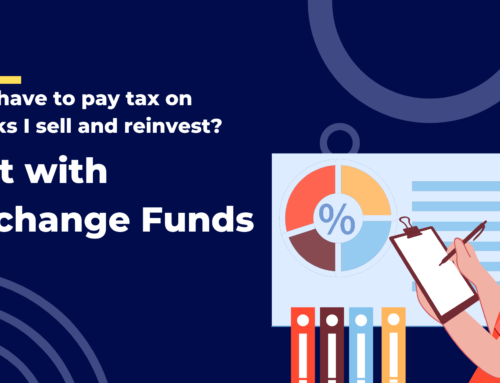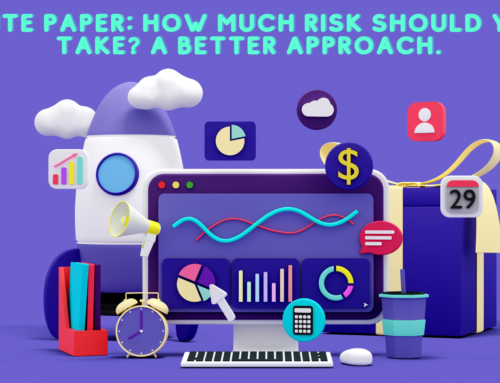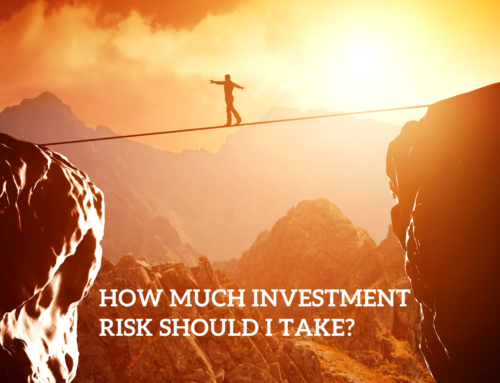2022 was a bad year for both stock and bond markets around the world, something I covered in detail in my last post. But there’s a silver lining to last year’s storm: bad returns over the short term often means better returns over the long term. In fact, most investors with a long time horizon might actually be better off after the 2022 bear market than if returns had been positive instead. For long term investors, bad returns can be good news.
This idea might not sound so counterintuitive to some. Many investors often have the contrarian impulse to “buy the dip” and invest more money after markets have taken a beating. This can be a good strategy, but the motivation is usually a bit different than what I plan to talk about today. In my experience, investors who talk about “buying the dip” often do so based on the intuition that the market will soon “rebound” and recover its losses. This may or may not be true on average (the long-term evidence is mixed), but is not what I’m talking about here. In fact, I’m actually hoping that markets don’t recover their 2022 losses and return to where they were in 2021. Why? Because today’s lower asset prices means better valuations and higher yields, which means that stocks and bonds are now capable of delivering higher returns indefinitely into the future than they would if prices were higher. Because I’m a young investor with a long time horizon, I expect that if valuations stay where they’re at today I’ll end up having much more money in retirement than I would if valuations rebound to their 2021 levels. Nor is this just a selfish consideration for young investors. I expect nearly all our clients will benefit if valuations remain at their 2022 versus 2021 levels. As we’ll see, almost any investor with a time horizon of at least a handful of years can be better off from the bad returns of 2022.
Prices, Yields, and Returns
When asset prices fall, yields rise. Whether we’re talking about the interest payments on bonds or the earnings or dividends on stocks, these income payments become larger relative to the price of the investment, even if they remain constant in absolute terms. So yields on stock and bond market were higher at the end of 2022 than they were the year prior. Below I show the estimated yield-to-maturity on the aggregate US bond market (Bloomberg US Aggregate Bond index) and the earnings yield on the global stock market (MSCI ACWI).

Bond yield is based on yield-to-maturity of iShares US Core US Aggregate Bond ETF (AGG), as provided by BlackRock. Stock yield is based on reciprocal of CAPE ratio on MSCI ACWI, as provided by Research Affiliates. Analysis by RHS Financial.
If prices remain constant, the return on a bond (or portfolio of bonds) will be equal to its yield. For stocks, the logic is a little more complicated because generally there’s growth in the underlying financials, but under certain assumptions the (real) return should be equal to the earnings yield, and in practice this does seem to be approximately true, at least at the aggregate market level over the long run. This means now that these stock and bond market yields are higher, if the yields don’t change then they will earn higher returns on average indefinitely into the future, relative to what they would have done if they stayed at circa-2021 yields. This means that even with the loss of principal associated with a bad year like 2022, eventually the higher yields generate enough income that the investment out-earns what it would have made without the losses in the first place.
This might sound like magic at first. How can an investment earn higher returns just because the price has fallen even if the income payments haven’t changed at all? Consider a 10-year bond issued at par for $1,000 paying $20 annual interest: a 2% yield. Now suppose the price of the bond falls to $768.50; for a 10-year bond this corresponds with the yield rising to 5%. Now, you might think that this might make the bond attractive for new investors who haven’t bought it yet, but it can’t be any good for an investor who already bought at par, can it? An investor who buys at par and holds to maturity earns the same $20 interest payments and receives their principal back at maturity. They may ultimately be no worse off from the drop in price once they receive their principal back, but how can they be better off if the income they’re receiving hasn’t changed?
The key is that those fixed $20 interest payments will be reinvested into something: more of the same bond or other similar bonds or something. But because the prices are now lower those reinvested cashflows will buy more of the same bond than they could otherwise, i.e., they earn a higher yield. This effect will be small at first but compounds over time. Eventually the investor will reach a breakeven point where they have made more money as a result of the initial price drop than they would have if yields had remained constant over time.
We can use this concept to work out how much faster investors’ wealth will compound now that yields are higher post-2022 and how long it will take until they’re better off than if valuations had stayed at their 2021 levels. But first we should account for inflation.
Ultimately what investors mostly care about is eventually redeeming their investments for real goods and services they can consume, so when making projections of investment growth into the future it’s usually desirable to do so on an after-inflation or real basis. So it’s real yields we’re actually interested in. This is especially salient right now of course because the big story of 2022 was the run-up in inflation to multi-decade highs, which was one of the key reasons for losses in stock and bond markets, as I discussed last time. In fact, you may be wondering if the rise in inflation more than cancels out the rise in yields. After all, inflation in the US was 6.45% in 2022, higher than the current yield on either stocks or bonds. Does that mean we’re looking at negative real returns going forward?
Not so fast. First of all, the yield on stocks depicted above is the earnings yield, which is already essentially a real yield (earnings tend to grow at least as fast as inflation in the long run). As mentioned above, the earnings yield approximates the real return on stocks in the long run. If we want to forecast the nominal return on stocks it’s common to take the earnings yield and add an inflation forecast to it. Bonds, on the other hand, have a nominal, fixed income, so if we want to get the real yield we take the nominal yield and subtract our forecast of inflation. But while the 6.45% inflation of 2022 added insult to the injury of negative market returns, the consensus among economists and market participants is that inflation will be quite a bit lower than that going forward. Importantly, while actual inflation spiked significantly in 2022, expected inflation (especially long-term inflation) rose much less, indeed much less than yields rose by, and so estimated real yields are now much higher.
According to the Federal Reserve’s Survey of Professional Forecasters, the average expected inflation rate over the next ten years was 2.95% as of the end of 2022. This is only slightly higher than the average forecast as of the end of 2021: 2.55%. Let’s use these figures and subtract them from the bond yields above to get real yields for 2021 and 2022.

Bond yield is based on yield-to-maturity of iShares US Core US Aggregate Bond ETF (AGG), as provided by BlackRock, minus average 10-year inflation forecast, as provided by the Survey of Professional Forecasters. Stock yield is based on reciprocal of CAPE ratio on MSCI ACWI, as provided by Research Affiliates. Analysis by RHS Financial.
Bonds had a negative real yield as of the end of 2021, as they’d had for most of the last decade. Now they’re positive. You probably don’t need to be a financial wiz to understand that investments that are paying more than inflation are better for building wealth than investments that are paying less than inflation.
Now let’s see how long it will take stocks and bonds to break even, given these new, higher yields, compared to what would have happened if the 2022 bear market never happened and real yields remained constant where they were at. Below I plot the real investment growth for bonds out to 2050 under two scenarios: Under the “2021 Path” I pretend that 2022 never happened and that bonds earned their real yield as of the end of 2021 that year (-0.9%) and for every subsequent year thereafter. Under the “2022 Path” I first plot the actual returns that bonds experienced last year, dragging them down about 13% in the hole. Then starting in 2023 they earn their real yield as of the end of 2022 (1.7%) over every subsequent year.

Projection is based on yield figures discussed above and is a hypothetical illustration that does not include taxes, transactions costs, or other fees. For illustrative purposes only and not an assurance of actual returns. Analysis by RHS Financial.
If bond investors hadn’t suffered through 2022 they’d be well ahead of where they are today, but with negative real yields their wealth would only slowly erode over time. With the higher, positive real yields we now see on bonds, however, bond investors at the turn of 2023 can start to dig themselves out of their hole. The two paths depicted cross paths in early 2028 while they’re both still underwater versus their principal, but the 2022 path keeps climbing, recovers back into positive territory a few years later, and continues compounding from there.
It’s important to note here that these projections are based on the assumption that yields stay constant over time. Obviously this is not realistic; yields will fluctuate up and down with the ebb and flow of the market. But it’s not at all obvious whether the secular trend from here will be up or down, so these lines basically represent the expected value of the growth of these investments. The upshot is that if bond markets quickly bounce back and yields return to their previous levels, that will put us closer on the 2021 path – helping in the short run but hurting in the long run. On the other hand, if yields continue to rise from here, that will further exacerbate losses but only magnify the ultimate long-term growth trajectory of the investment.
Now let’s look at stock investments. Below I depict the same exercise done for a global stock investment.

Projection is based on yield figures discussed above and is a hypothetical illustration that does not include taxes, transactions costs, or other fees. For illustrative purposes only and not an assurance of actual returns. Analysis by RHS Financial.
The 2022 change in yields was not as extreme for stocks as it was for bonds, and so the difference in the wealth compounding effect is not as large, which means it takes the 2022 path much longer to catch up to the 2021 path in this scenario. On the hand, with higher real yields than those offered on bonds, wealth compounds much faster with stocks under either scenario. The 2022 path recovers its losses in real terms around the end of 2027. By 2044 real wealth has doubled since the start of 2022, and by 2049 stock investors are finally better off than they would have been if 2022 had never happened.
From Real Yields to Real Wealth
This “good news” might sound like cold comfort to some investors. It will take nearly a decade to earn back our bond losses and nearly three decades to be better off with our stocks? Yes, but only in the case of a one-time, lump-sum investment made at the end of 2021. Most people do not invest this way, but make contributions steadily over the course of their career, followed by steady withdrawals in retirement. For investors following a typical investment lifecycle, the good news of higher yields will pay off quicker and be much more significant over the course of their lifetime.
To illustrate this, let’s consider five hypothetical investors who are identical except for their age and initial wealth as of the end of 2021. These investors will all retire when they are 65 years old, will invest $1,875 each month while they’re working ($22,500 per year, the current maximum employee contribution for 401(k) accounts), will withdraw $5,000 per month when they are retired, will pass away when they’re 95 years old, and will follow an asset allocation glide path of holding “120 minus their age” in stocks, i.e., a 30-year old is 90% invested in stocks/10% in bonds, a 40-year old is 80% stocks/20% bonds, and so on. Using the same methodology outlined for the real stock and bond paths above, I plot the simulated real wealth of five investors aged 30, 40, 50, 60, and 70 (note the last one is already retired) under the 2021 and 2022 paths. Let’s start youngest first.

Projection is based on yield figures discussed above and is a hypothetical illustration that does not include taxes, transactions costs, or other fees. For illustrative purposes only and not an assurance of actual returns. Analysis by RHS Financial.
Our 30-year old is assumed to live until the end of 2086, and over this 65 year long investment horizon, the losses of 2022 are barely visible. And because her contributions early in her career are large relative to her starting wealth and she is investing them at higher yields in the 2022 path, she catches up to the 2021 path by the end of 2031 despite being mostly invested in stocks. Notice how this is much sooner than the 2049 date corresponding to the lump-sum scenario above. After 2031, our young investor’s wealth continues to compound at a much faster pace under the 2022 path, resulting in roughly a half million dollars of additional real wealth at retirement. This extra cushion, plus the higher returns on offer, makes all the difference in retirement, as wealth declines very slowly post-retirement on the 2022 path, and she leaves behind a bequest of more than $1.5 million. On the 2021 path, however, our investor is in trouble, running out of money near the end of her life (I purposefully set the initial wealth for each of these cohorts such that the 2021 path terminates close to zero in order to allow easy comparison).
These scenarios are simplistic, of course; in reality our investor would probably adjust her consumption downward under the 2021 path, and might consume more on the 2022 path. But this illustrates the point that today’s higher yields will ultimately lead to greater real wealth for patient investors.
Let’s look at our 40-year old investor next.

Projection is based on yield figures discussed above and is a hypothetical illustration that does not include taxes, transactions costs, or other fees. For illustrative purposes only and not an assurance of actual returns. Analysis by RHS Financial.
Here, the 2022 losses start to become more evident, as the investor’s starting wealth of $500k is a larger proportion of his total lifetime wealth. But he catches up nearly as quickly, breaking even with the 2021 path in the year 2033. Terminal wealth at age 95 is nearly $1.5 million greater with higher yields.
Age 50:

Projection is based on yield figures discussed above and is a hypothetical illustration that does not include taxes, transactions costs, or other fees. For illustrative purposes only and not an assurance of actual returns. Analysis by RHS Financial.
The 50-year old breaks even the same year as the 40-year old in 2033 despite the higher starting wealth due to the higher allocation to bonds, which break even faster than stocks. The 50-year old’s terminal wealth is about $1 million greater under the higher yield scenario.
Age 60:

Projection is based on yield figures discussed above and is a hypothetical illustration that does not include taxes, transactions costs, or other fees. For illustrative purposes only and not an assurance of actual returns. Analysis by RHS Financial.
The 60-year old is only 5 years from retirement, and so investment losses might seem more precarious for her. Indeed, she doesn’t break even until well into retirement with higher yields, not until 2034, due to the fact she’s now withdrawing money and so doing the opposite of “reinvesting at higher yields”, she is forced to sell at lower prices. Nonetheless, compared to the 2021 path she’s still ultimately better off with higher yields, and her terminal wealth is about $400k greater with them.
Age 70:

Projection is based on yield figures discussed above and is a hypothetical illustration that does not include taxes, transactions costs, or other fees. For illustrative purposes only and not an assurance of actual returns. Analysis by RHS Financial.
Investors who are already retired and living off their portfolio principal are the ones most plausibly made worse off by the 2022 bear market. They don’t have the option of investing income at higher yields and must sell at losses to fund consumption. Despite being mostly invested in bonds, our 70-year old does not break even with higher yields until 2038 when he’s in his mid-80s, much later than under a lump-sum scenario. Still, you can’t take it with you, and for such investors the greatest risk is “longevity risk”, the risk of living long and running out of money before you die. If our 70-year old lives long enough he will eventually be better off with higher yields, and his portfolio will last a little bit longer under the 2022 path despite the initial investment losses.
So rejoice, investors, because bad returns are good news! And hope not for a swift recovery from our recent bear market, but for persistently high yields into the future!
Please take a look at our disclosures HERE.






